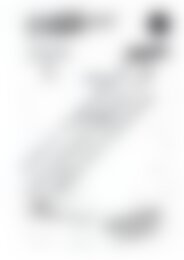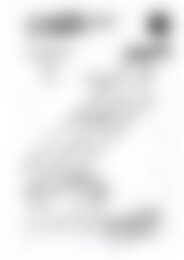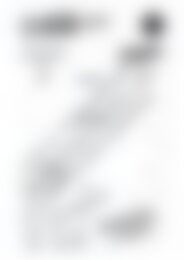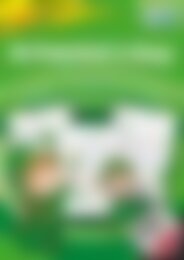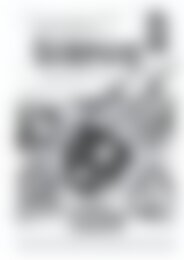RIC-6835 Maths Essentials - Geometry and Measurement 1 (Ages 11-15)
You also want an ePaper? Increase the reach of your titles
YUMPU automatically turns print PDFs into web optimized ePapers that Google loves.
<strong>Geometry</strong> <strong>Measurement</strong> Chance <strong>and</strong> data<br />
<strong>Maths</strong><br />
Units of<br />
measurement<br />
Length<br />
mm<br />
cm<br />
m<br />
km<br />
Area<br />
mm 2<br />
cm 2<br />
m 2<br />
km 2<br />
ha<br />
Capacity<br />
mL<br />
L<br />
kL<br />
Mass<br />
mg<br />
g<br />
kg<br />
t<br />
millimetre<br />
centimetre<br />
metre<br />
kilometre<br />
square millimetre<br />
square centimetre<br />
square metre<br />
square kilometre<br />
hectare<br />
millilitre<br />
litre<br />
kilolitre<br />
milligram<br />
gram<br />
kilogram<br />
tonne<br />
Temperature<br />
°C degree Celsius<br />
°F degree Fahrenheit<br />
K<br />
Time<br />
s<br />
min<br />
h<br />
d<br />
kelvin<br />
second<br />
minute<br />
hour<br />
day<br />
m. month<br />
yr or y.<br />
cent. or C<br />
year<br />
century<br />
<strong>Measurement</strong><br />
Mathematical terms<br />
arbitrary units<br />
Non-st<strong>and</strong>ard units of measure; e.g. h<strong>and</strong><br />
spans, counters, tiles, claps.<br />
area (a)<br />
The measurement of surfaces <strong>and</strong> regions,<br />
usually expressed in square units of<br />
measurement.<br />
base (b)<br />
A particular side of a shape from which the<br />
height of an object can be measured.<br />
capacity<br />
The amount of space inside a container.<br />
What it holds, measured in mL, L etc.<br />
circumference (c)<br />
The perimeter of a circle; the distance<br />
measured around a circle.<br />
diameter (d)<br />
Straight line passing through the centre of<br />
a circle <strong>and</strong> terminating at each end by the<br />
circumference.<br />
height (h)<br />
The highest part of a shape from the base.<br />
length (l)<br />
The distance measured from end to end.<br />
mass (weight)<br />
The amount of matter in an object.<br />
Rules <strong>and</strong> formulas<br />
Circle<br />
Circumference:<br />
= 2 r or x d<br />
diameter<br />
radius<br />
Rectangle<br />
Prisms<br />
Area:<br />
= r 2<br />
Perimeter:<br />
= 2 x (l + w)<br />
Area:<br />
= l x w<br />
length<br />
V = A x H<br />
V = (l x w) x H<br />
side<br />
width<br />
Triangle<br />
Perimeter:<br />
= s + s + s<br />
Area:<br />
= 1 2<br />
x (b x h)<br />
base<br />
V = A x H<br />
V = b x h x H<br />
2<br />
perimeter (p)<br />
The length of the boundary of a plane region. In a<br />
polygon, it is the sum of the lengths of all sides.<br />
pi ( )<br />
The ratio of the circumference of a circle to its<br />
diameter. It is approximately 3.14<br />
Pythagoras’s theorem<br />
The square of the hypotenuse is equal to the sum<br />
of the squares of the other two sides.<br />
c 2 = a 2 + b 2<br />
c 2 = a 2 + b 2<br />
b c = hypotenuse<br />
a 2 = c 2 – b 2<br />
b 2 = c 2 – a 2<br />
a<br />
radius (r)<br />
The distance from the centre of a circle to a<br />
point on its circumference.<br />
side (s)<br />
The edge of a 2-D shape.<br />
surface area (sa)<br />
The total area of the outside surface of a 3-D<br />
shape.<br />
volume (v)<br />
The amount of space occupied by an object.<br />
width (w)<br />
The distance from one side to another; the<br />
breadth (b).<br />
height<br />
Parallelogram<br />
A = bh<br />
Area = base x height<br />
The surface area (TSA)<br />
The total area of the outside of a 3D shape;<br />
e.g. for a rectangular prism<br />
TSA = (2 x Area 1) + (2 x Area 2) + (2 x Area 3)<br />
rectangular<br />
prism<br />
triangular<br />
prism<br />
b<br />
cylinder<br />
h<br />
V = A x H<br />
V = ( r 2 ) x H<br />
Trapezium<br />
a<br />
h(a + b)<br />
A =<br />
2<br />
Area = sum of two<br />
parallel sides<br />
x height, halved<br />
b<br />
Square<br />
Perimeter:<br />
= 4 x l<br />
Area:<br />
= l x l<br />
or<br />
= l 2<br />
1<br />
3<br />
cube<br />
h<br />
2<br />
V = l x w x h<br />
Surface area = 6 x (l x h)<br />
length<br />
Presenting data<br />
Pie<br />
graph<br />
Portions of<br />
a circle are<br />
used to show<br />
a whole<br />
divided into<br />
parts.<br />
Line graph<br />
A graph which has a vertical <strong>and</strong><br />
a horizontal axis <strong>and</strong> is formed by<br />
joining points with straight lines<br />
or a curve to represent data.<br />
Box-<strong>and</strong>-whisker plot<br />
Chance <strong>and</strong> data<br />
Histogram<br />
Is used to represent small or large<br />
amounts of data.<br />
For example:<br />
The box shows the median, upper <strong>and</strong> lower quartiles (<strong>and</strong> interquartile range).<br />
The ends of the whiskers show the lowest <strong>and</strong> highest values in the data (the<br />
range).<br />
Multiple bar graph<br />
Can be used to graphically<br />
compare two sets of data.<br />
Fixed data is placed on the<br />
horizontal axis.<br />
Statistics<br />
Sport played<br />
No. of<br />
students<br />
Soccer 34<br />
T-ball 8<br />
Swimming 50<br />
Netball 34<br />
football 24<br />
basketball 50<br />
Collecting <strong>and</strong> classifying<br />
information <strong>and</strong> data from a<br />
sample for a specific purpose<br />
Data can be collected from a set<br />
group of people or from a ‘r<strong>and</strong>om<br />
sample’.<br />
A r<strong>and</strong>om sample is where every<br />
member of the sample has an equal<br />
chance of being chosen.<br />
For example:<br />
Test scores from a r<strong>and</strong>om group<br />
of students were collected. They are<br />
as follows:<br />
<strong>11</strong> 18 13 16 16 16 19<br />
12 <strong>15</strong> 14<br />
Percentage<br />
34<br />
x 100 200<br />
8<br />
200 x 100<br />
50<br />
x 100 200<br />
34<br />
x 100 200<br />
24<br />
x 100 200<br />
50<br />
x 100 200<br />
Information can be presented in many different ways.<br />
Bar graph<br />
A graph which represents information regarding frequency of outcomes<br />
using bar lengths. The graph has a vertical <strong>and</strong> horizontal axis. The bars<br />
may be vertical or horizontal.<br />
Stem-<strong>and</strong>-leaf plots<br />
Arranges data to show its shape <strong>and</strong><br />
distribution. It may be used to calculate the<br />
mean, median <strong>and</strong> mode of a set of data.<br />
Each data value is split into a ‘stem’ <strong>and</strong> a<br />
‘leaf’. In this case the leaf represents the unit<br />
digit <strong>and</strong> the stem represents all others.<br />
23, 25, 21<br />
32, 35<br />
47, 49<br />
represented as:<br />
stem leaf<br />
2<br />
3<br />
4<br />
3 5 1<br />
2 5<br />
7 9<br />
Scatter graph<br />
Used to compare two sets of data to determine if there is a<br />
correlation between them. The dots on the scatter graph represent<br />
the data points for each person. A straight line of best fi t may be<br />
drawn.<br />
NOTE<br />
Scatter graphs may<br />
show:<br />
weak strong<br />
positive relationships<br />
weak strong<br />
negative relationships<br />
no relationship<br />
©R.I.C. Publications<br />
Low Resolution Images<br />
Display Copy<br />
This graph shows a weak<br />
positive relationship.<br />
Once the data is collected it can be used to calculate:<br />
range (of a distribution)<br />
The difference between the greatest <strong>and</strong> least<br />
values in a set of data.<br />
For example:<br />
The greatest value is 19, the least value is <strong>11</strong>.<br />
Therefore, the range is 19 – <strong>11</strong> = 8.<br />
mode<br />
The measurement or observation that<br />
occurs most often; the item with the highest<br />
frequency.<br />
For example:<br />
The test score which occurs most frequently is<br />
16. The mode is 16.<br />
bimodal: can have more than one mode.<br />
mean (average)<br />
The mean of a set of numbers is a single number used to<br />
represent the set. It is calculated by dividing the sum of the<br />
numbers by the number in the sample.<br />
For example:<br />
<strong>11</strong> + 18 + 13 + 16 + 16 + 16 + 19 + 12 + <strong>15</strong> + 14 = <strong>15</strong>0<br />
<strong>15</strong>0 ÷ 10 (students) = <strong>15</strong> The mean is <strong>15</strong>.<br />
median<br />
The middle measurement, or score, when items are<br />
arranged in order of size. Where there is no middle score,<br />
the mean of the two central scores is taken.<br />
For example:<br />
<strong>11</strong>, 12, 13, 14, <strong>15</strong>, 16, 16, 16, 18, 19<br />
The median is<br />
<strong>15</strong> + 16<br />
= <strong>15</strong>.5<br />
2<br />
Chance<br />
The likelihood of an event occurring.<br />
For example:<br />
We have a 1 in 6 chance of throwing a 6 on a die. This would be written as 1 6 .<br />
Some common terms used in chance are:<br />
probability (P)<br />
The likelihood of a particular outcome in a chance event.<br />
For example:<br />
The probability of throwing a ‘head’ on the toss of a coin is 1 2 .<br />
Probabilities are always written as fractions or decimals between 0 <strong>and</strong> 1.<br />
Anything which has no chance of happening has a probability of 0.<br />
Things that are certain to happen have a probability of 1.<br />
To fi nd the probability of an event, use this calculation:<br />
P (event) =<br />
This is broken into:<br />
experimental probability<br />
When experiments need to be undertaken to gather<br />
data in order to calculate the probability of an event.<br />
Diagrams <strong>and</strong> tables<br />
Tree diagram<br />
These are used for classifi cation activities<br />
or to show possible outcomes of chance<br />
events.<br />
Tally<br />
Surveys<br />
Develop an<br />
objective question<br />
to ask the sample.<br />
Provide categories<br />
for answers.<br />
Use tallies <strong>and</strong><br />
tables to record<br />
data.<br />
Present data in a<br />
format which is<br />
easy to read.<br />
This is a stroke which is used to record<br />
items. Tallies generally use a diagonal stroke<br />
on the fi fth item.<br />
For example:<br />
Some data is best displayed in a diagram. There are many different types to choose from.<br />
Table<br />
These are used to organise data for a<br />
particular purpose.<br />
Number of children in each team<br />
Blue Red Green Gold<br />
Boys 46 43 49 32<br />
Girls 40 50 35 49<br />
Total 86 93 84 81<br />
Chance <strong>and</strong> data<br />
number of favourable outcomes<br />
total number of outcomes<br />
complement<br />
Every outcome has a complement.<br />
For example:<br />
‘winning’ <strong>and</strong> its complement, ‘not winning’ or ‘rolling a six’ <strong>and</strong> its complement,<br />
‘not rolling a six’.<br />
P(event occurring) + P(event not occurring) = 1 or<br />
outcome<br />
P(event not occurring) = 1 – P(event occurring)<br />
A result.<br />
Array<br />
An arrangement of numbers<br />
in rows <strong>and</strong> columns; eg a<br />
matrix.<br />
Pascal’s triangle is<br />
another example.<br />
Each entry is the sum<br />
of the two numbers<br />
directly above it.<br />
x x x x<br />
x x x x<br />
x x x x<br />
sample space (S)<br />
A list or diagram of all possible outcomes.<br />
For example:<br />
Tossing a coin:<br />
the sample space is the set {head, tail}.<br />
Tossing a single die:<br />
the sample space is {1, 2, 3, 4, 5, 6}<br />
theoretical probability<br />
To calculate the probability of an<br />
event.<br />
Two-way table<br />
These are used to display data that is<br />
related to each other.<br />
Even<br />
= 12<br />
Venn diagram<br />
Named after John Venn, an English logician.<br />
This diagram is used to represent the<br />
classifi cation of sets of items. It is possible<br />
to make a Carroll diagram from any Venn<br />
diagram.<br />
Carroll diagram<br />
Named after Lewis Carroll; author,<br />
mathematician <strong>and</strong> logician. This diagram is<br />
useful when recording classifi cation data.<br />
Not even<br />
Square 4, 16 1, 9<br />
Not<br />
square<br />
2, 6, 8, 10, 12,<br />
14, 18, 20<br />
3, 5, 7, <strong>11</strong>,<br />
13,<strong>15</strong>, 17, 19<br />
<strong>6835</strong>RE maths 2 y9.indd 1<br />
13/10/05 2:28:30 PM
Equivalent measures<br />
Capacity<br />
Length<br />
1 000 000 cm 3 = 1 m 3<br />
10 mm = 1 cm<br />
100 cm = 1 m<br />
1000 m = 1 km<br />
Time<br />
Area<br />
100 mm 2 = 1 cm 2<br />
10 000 cm 2 = 1 m 2<br />
10 000 m 2 = 1 ha<br />
100 ha = 1 km 2<br />
Mass<br />
1000 mg = 1 g<br />
1000 g = 1 kg<br />
1000 kg = 1 t<br />
Volume<br />
1000 mm 3 = 1 cm 3<br />
Angles of elevation<br />
The angle of elevation is the angle ray AB<br />
makes with the horizontal.<br />
Angles of depression<br />
The angle of depression is the angle ray CD<br />
makes with the horizontal.<br />
Trigonometric ratios<br />
How to choose a trigonometric ratio:<br />
For right angled triangles:<br />
θ<br />
Hypotenuse<br />
Adjacent<br />
Opposite<br />
1. Label each side of the triangle with O, A <strong>and</strong> H.<br />
2. Decide which two sides are part of the problem.<br />
3. Use: SOH sin θ = O<br />
H or<br />
CAH cos θ = A<br />
H or<br />
O<br />
TOA tan θ =<br />
A<br />
to solve the problem.<br />
<strong>Measurement</strong><br />
<strong>Measurement</strong><br />
1000 mL = 1 L<br />
1000 L = 1 kL<br />
60 seconds = 1 minute<br />
60 minutes = 1 hour<br />
24 hours = 1 day<br />
7 days = 1 week<br />
14 days = 1 fortnight<br />
28–31 days = 1 month<br />
~ 52 weeks = 1 year<br />
12 months = 1 year<br />
365 days = 1 year<br />
366 days = 1 leap year<br />
10 years = 1 decade<br />
100 years = 1 century<br />
1000 years = 1 millennium<br />
Unknown side<br />
Label it with a pronumeral (x) <strong>and</strong><br />
calculate.<br />
<strong>15</strong>º<br />
x mm (H)<br />
For example:<br />
20<br />
sin <strong>15</strong>° = x<br />
20<br />
x = sin <strong>15</strong>°<br />
x = 77.3 mm<br />
20 mm<br />
(O)<br />
Decimal measures<br />
Decimal measures<br />
<strong>Measurement</strong>s should be written in decimal<br />
form where possible.<br />
For example:<br />
10 cm, 3 mm 10.3 cm<br />
2 m, 7 cm, 5 mm 2.075 m<br />
3 km, 408 m, 52 cm 3.40852 km<br />
6 L, 430 mL 6.430 L<br />
<strong>15</strong> kL, 675 L <strong>15</strong>.675 kL<br />
12 g, 325 mg 12.325 g<br />
4 kg, 75 g 4.075 kg<br />
5 t, 620 kg 5.620 t<br />
Temperature<br />
A thermometer is used to measure<br />
temperature.<br />
Freezing<br />
point of<br />
water:<br />
0 °C<br />
Measuring tools<br />
Various tools are used to measure in<br />
different situations. For example:<br />
length<br />
mass<br />
capacity<br />
Unknown angle<br />
Choose the trigonometric ratio<br />
using the steps shown <strong>and</strong> calculate.<br />
For example:<br />
θº<br />
2<strong>15</strong> cm (A)<br />
Boiling<br />
point of<br />
water:<br />
100 °C<br />
ruler<br />
tape measure<br />
trundle wheel<br />
balance<br />
kitchen scales<br />
bathroom scales<br />
measuring spoons<br />
measuring cups<br />
measuring jugs<br />
graduated cylinders<br />
tan θ = O A<br />
84<br />
= 2<strong>15</strong><br />
θ = tan ( 2<strong>15</strong>)<br />
–1 84<br />
θ = 21.3°<br />
84 cm<br />
(O)<br />
2-D shapes<br />
2-D shapes have two dimensions—width <strong>and</strong> length.<br />
They may have curved or straight sides.<br />
Shapes with straight sides are called<br />
‘polygons’. Polygons have three or more<br />
sides <strong>and</strong> angles.<br />
Polygons with sides of an equal length <strong>and</strong><br />
angles of an equal size are called regular<br />
polygons.<br />
Polygons with three sides are called ‘triangles’.<br />
3-D shapes<br />
Parts of a 3-D shape include:<br />
faces<br />
The surfaces of a three-dimensional fi gure.<br />
edges<br />
The intersections of two faces of a<br />
three-dimensional fi gure.<br />
vertices<br />
The intersections of three edges of a threedimensional<br />
fi gure.<br />
<strong>Geometry</strong><br />
<strong>Geometry</strong><br />
Polygons with four sides are called<br />
‘quadrilaterals’.<br />
Quadrilaterals with opposite sides parallel<br />
are called ‘parallelograms’.<br />
Other shapes include circles, semicircles <strong>and</strong><br />
ellipses.<br />
prisms<br />
If the two ends of a prism are<br />
the same size <strong>and</strong> shape; they<br />
are congruent.<br />
Nets<br />
A net is a 2-D plan which can be used to<br />
make a 3-D shape.<br />
Three-dimensional shapes are also called ‘solid figures’. A 3-D shape has length, width<br />
<strong>and</strong> height.<br />
©R.I.C. Publications<br />
Low Resolution Images<br />
Display Copy<br />
regular polyhedra<br />
The faces of these 3-D shapes are all the same shape<br />
<strong>and</strong> size. There are fi ve: tetrahedron, octahedron,<br />
hexahedron, icosahedron <strong>and</strong> dodecahedron.<br />
pyramids<br />
A pyramid is made up of a base shape such as a<br />
triangle, square, hexagon or decagon.<br />
The opposite end of the shape forms a point<br />
called an ‘apex’.<br />
Angles<br />
An angle (<br />
acute angle<br />
An angle less than 90°.<br />
right angle<br />
An angle of exactly 90°.<br />
obtuse angle<br />
An angle between<br />
90° <strong>and</strong> 180°.<br />
reflex angle<br />
An angle between<br />
180° <strong>and</strong> 360°.<br />
The four angles in a<br />
quadrilateral add up to<br />
360º.<br />
rectangle<br />
90º + 90º + 90º + 90º = 360º<br />
rhombus<br />
a + b + a + b = 360°<br />
parallelogram<br />
a + b + a + b = 360º<br />
acute<br />
angle<br />
right<br />
angle<br />
obtuse angle<br />
reflex angle<br />
straight angle<br />
An angle which is exactly<br />
180°.<br />
straight angle<br />
complementary<br />
angles<br />
Two angles which add to<br />
90° (a right angle).<br />
) is formed when two lines meet. Angles are measured in degrees.<br />
A degree ( ) is a unit of angular measure. There are 360° in one complete<br />
rotation.<br />
A protractor is a tool used to measure the size of an angle.<br />
Quadrilaterals<br />
50°<br />
40°<br />
supplementary angles<br />
Two angles which<br />
add to 180° (a<br />
straight angle).<br />
corresponding<br />
angles<br />
alternate angles<br />
co-interior<br />
angles<br />
<strong>Geometry</strong><br />
<strong>Geometry</strong><br />
50°<br />
130°<br />
vertically opposite angles<br />
Congruent angles formed when two lines<br />
intersect.<br />
Mathematical terms<br />
attribute<br />
A characteristic of an object. A<br />
way to classify objects; e.g. round,<br />
red, thick.<br />
classification<br />
Arrangement into classes<br />
(sets or groups) according to<br />
attributes.<br />
congruent<br />
Two fi gures are congruent if they<br />
are the same size <strong>and</strong> shape.<br />
coordinates<br />
A referenced point on a grid can<br />
be found using an ‘ordered pair’<br />
of numbers. These are called the<br />
coordinates of the point. The<br />
horizontal axis is always read or<br />
written before the vertical axis.<br />
line<br />
Made up of an infi nite set<br />
of points extending in both<br />
directions.<br />
line segment<br />
A line with two end points.<br />
model<br />
A representation of an object<br />
preserving the signifi cant<br />
features.<br />
net<br />
A fl at pattern that can be folded<br />
to make a three-dimensional<br />
model.<br />
network<br />
A system of lines (paths) <strong>and</strong><br />
nodes (points representing<br />
intersections).<br />
parallel lines<br />
Two or more straight lines in<br />
the same plane which will never<br />
meet. They are always the same<br />
distance apart.<br />
path<br />
A line connecting points (nodes)<br />
in a network.<br />
perpendicular lines<br />
Two lines which form right angles.<br />
plane<br />
A surface which is fl at <strong>and</strong> has no<br />
boundaries.<br />
Triangles<br />
Triangles<br />
angles in a triangle<br />
Triangles can be named according to the size<br />
of their angles.<br />
exterior angles<br />
The exterior angle<br />
of a triangle is<br />
equal to the sum of<br />
the two opposite<br />
interior angles.<br />
congruent triangles<br />
Triangles are congruent if they are identical<br />
in shape <strong>and</strong> size.<br />
Two triangles can be called congruent if:<br />
SSS: all sides the same length or<br />
SAS: two sides the same <strong>and</strong> the angle<br />
between those sides the same or<br />
ASA: two angles the same <strong>and</strong> the side<br />
between those angles the same length<br />
or<br />
RHS: If the hypotenuse <strong>and</strong> a side of one<br />
triangle are respectively equal to the<br />
hypotenuse <strong>and</strong> a side of the other<br />
triangle, then the two right triangles<br />
are congruent.<br />
ray<br />
Made up of an infi nite set of<br />
points emanating from a point<br />
<strong>and</strong> going in one direction.<br />
scale<br />
The ratio of measurements<br />
of a model or diagram to<br />
corresponding measurements of<br />
an enlarged or reduced version.<br />
section<br />
A fl at surface made by cutting<br />
through a solid in any direction.<br />
similar<br />
Two shapes are similar when<br />
they have the same shape but are<br />
different in size.<br />
tessellation<br />
A repeating pattern of congruent<br />
shapes that completely cover an<br />
area leaving no gaps or overlaps.<br />
traversable<br />
A network is traversable if all<br />
paths can be traced over without<br />
going over the same path twice.<br />
<strong>Maths</strong><br />
No part of this publication may be reproduced in any form or<br />
by any means, electronic or mechanical, including photocopying<br />
or recording, or by any information storage <strong>and</strong> retrieval<br />
system, without written permission from the publisher.<br />
<strong>RIC</strong>–<strong>6835</strong><br />
Copyright Information<br />
9!BMFBI







